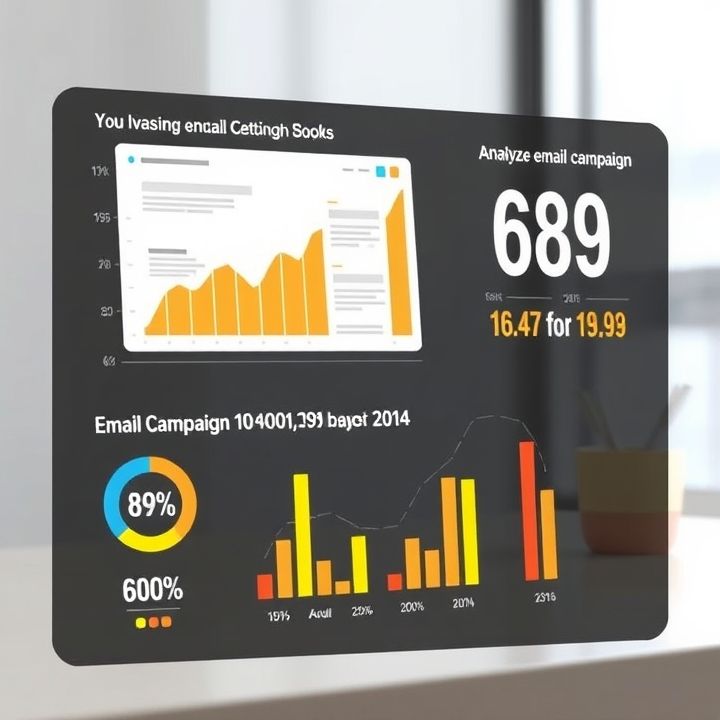Table of Contents
- Introduction
- Identifying the unique strengths of email marketing and other channels
- Aligning brand messaging across email and social media platforms
- Leveraging content marketing to enhance email campaign effectiveness
- Utilizing social media to grow email subscriber lists
- Personalizing cross-channel experiences for targeted engagement
- Creating data-driven strategies for integrated marketing efforts
- Analyzing performance metrics across all marketing channels
- Adapting to emerging trends in multichannel marketing integration
- Conclusion
- Frequently Asked Questions
Introduction
Welcome to the dynamic intersection where digital marketing efforts combine for explosive growth! In today’s ever-evolving marketplace, the fusion of email marketing, social media, and content strategies isn’t just an advantage—it’s a necessity. Are you ready to discover the powerhouse tactics that can propel your brand into new heights? This ultimate guide will provide you with the comprehensive insights needed to create campaigns that not only engage but also convert.
| Strategy | Key Benefit |
|---|---|
| Email Marketing | Direct reach to your customers’ inboxes |
| Social Media | Widespread engagement and brand building |
| Content Strategy | Boosts SEO and builds authority |
Prepare to unlock the secrets to synergizing these powerful tools effectively. Whether you’re aiming for higher open rates or more robust customer interactions, mastering this triad will transform your approach from a simple campaign creator to a sophisticated marketing strategist. So, buckle up as we delve into the best practices, tools, and trends to make your marketing skyrocket.
Identifying the unique strengths of email marketing and other channels
Email marketing stands out as a direct and highly personal means of reaching your audience. It allows businesses to deliver tailored content directly to the consumer’s inbox, ensuring a level of engagement that is often more intimate than other channels. With email, personalization is key; crafting messages that resonate with individuals based on their behavior and preferences can lead to higher conversion rates. Additionally, email marketing offers measurable metrics such as open rates, click-through rates, and conversion metrics, which provide invaluable insights into the effectiveness of campaigns.
On the other hand, social media marketing excels in its broad reach and viral potential. It enables brands to engage with a vast audience, encouraging interaction and fostering community. Social media platforms are ideal for building brand awareness and generating buzz around new products or services quickly. Meanwhile, content marketing provides the depth and expertise necessary to establish authority in a particular niche. Through blogs, whitepapers, and videos, businesses can educate their audience, nurturing leads, and building trust over time. Integrating these channels with email marketing helps develop a cohesive strategy, leveraging each platform’s strengths to achieve overarching marketing goals.
Aligning brand messaging across email and social media platforms
Aligning brand messaging across email and social media platforms is crucial for maintaining a cohesive and recognizable brand identity. This consistency helps in reinforcing the brand’s message, building trust, and engaging audiences effectively. To begin, it’s essential to establish a clear brand tone and voice that resonates with your target audience, ensuring it is reflected consistently in both email content and social media posts. By doing so, you create a seamless experience for your audience as they transition from one platform to another.
An effective strategy involves coordinating campaigns, so they complement rather than compete with each other. For instance, an upcoming product launch can be teased on social media platforms to build anticipation, followed by a detailed email campaign offering exclusive insights or promotional offers. Additionally, using cross-platform analytics tools can provide valuable insights into audience behavior, allowing for more tailored content creation.
Visual elements should also be unified. Using similar color schemes, logos, and imagery helps reinforce brand recognition, no matter where your content is viewed. By embedding social media icons in your emails and encouraging social sharing, you further increase the synergy between these channels, amplifying your brand’s reach and impact.
Leveraging content marketing to enhance email campaign effectiveness
Integrating content marketing with email campaigns can significantly improve effectiveness by fostering engagement and delivering value directly to the audience. Firstly, high-quality, relevant content should be crafted to resonate with your target audience. This content can be educational, entertaining, or informative, ensuring it aligns with the interests and needs of your subscribers. Once created, this content can be seamlessly incorporated into your email marketing strategy by using newsletters or automated email series to provide regular updates, highlight featured articles, or showcase in-depth guides.
Additionally, utilizing content marketing assets such as blogs, videos, and infographics within email campaigns can drive traffic back to your website or landing pages. This not only increases visibility but also encourages further interaction with your brand. To further enhance the effectiveness, personalize content by segmenting your email list based on user preferences and behaviors, ensuring that each subscriber receives content that is most relevant and beneficial to them. By leveraging the strengths of content marketing, businesses can create compelling email campaigns that build lasting relationships with their audience and drive higher engagement rates.
Utilizing social media to grow email subscriber lists
Utilizing social media to enhance email subscriber lists is a strategic approach that combines the personal touch of email marketing with the expansive reach of social media platforms. Start by leveraging your existing social media followers—individuals who are already engaged with your brand are likely to subscribe to your email list. Offer exclusive content or promotions to incentivize followers to join your email list, making them feel part of a special community.
Social media platforms like Facebook, Twitter, and Instagram can serve as effective channels for promoting sign-up forms. Pin your email sign-up message at the top of your social media profiles or use platform-specific features such as Instagram Stories’ ‘Swipe Up’ feature to direct users to your landing page. Hosting contests or giveaways on social media that require email sign-ups can also drive significant subscriber growth.
Ensure that any content you promote across social platforms is visually appealing and clearly communicates the benefits of subscribing. Collaborate with influencers who align with your brand to tap into their follower bases, offering additional pathways to grow your email list. By integrating these tactics, businesses can create a seamless journey from social media engagement to email subscription, effectively expanding their marketing reach.
Personalizing cross-channel experiences for targeted engagement
Personalizing cross-channel experiences for targeted engagement is essential for modern marketers looking to maximize their reach and impact. By leveraging data from various sources, such as customer behavior on social media, email interactions, and website visits, businesses can create a comprehensive view of their audience. This enables the crafting of personalized messages that resonate with the individual’s interests and preferences, regardless of the platform they are using.
One effective strategy is to use email marketing as the central hub for integrating other channels. For instance, enticing email calls to action can direct subscribers to related content on social media or a blog post, creating a seamless journey for the user. Additionally, social media engagement can inform email segmentation strategies, allowing for more tailored communication based on recipients’ interests observed on social platforms.
Automation tools also play a significant role in personalizing cross-channel marketing. These tools can analyze data in real time and adjust marketing efforts accordingly, ensuring that each touchpoint delivers consistent and relevant content. Ultimately, by aligning messages across channels and creating a cohesive brand experience, marketers can foster deeper connections with their audience, driving higher engagement and conversion rates.
Creating data-driven strategies for integrated marketing efforts
Creating data-driven strategies for integrated marketing efforts involves leveraging analytics and data insights to optimize the synergy between various marketing channels. This process begins with gathering data from all marketing initiatives, such as email campaigns, social media interactions, and content engagement metrics. By analyzing this data, marketers can identify trends and understand the preferences and behaviors of their target audience.
Once this foundational data is in place, the next step is to establish clear, measurable goals for each channel that align with the overall marketing strategy. These goals should focus on metrics like engagement rates, conversion rates, and customer acquisition costs. With goals in place, marketers can then develop personalized and targeted campaigns that ensure consistent messaging across all platforms.
An essential part of a data-driven approach is the continuous monitoring and analysis of campaign performance. This allows for real-time adjustments and optimizations to increase efficiency and results. Additionally, employing tools like CRM systems and cross-channel analytics platforms can provide a centralized view of the customer journey, enabling marketers to create seamless experiences that drive consumer satisfaction and brand loyalty.
Analyzing performance metrics across all marketing channels
Analyzing performance metrics across all marketing channels is essential for ensuring the synergy and effectiveness of your overall marketing strategy. Various metrics can provide insightful data about customer engagement, channel effectiveness, and conversion rates. Key performance indicators (KPIs) like open rates, click-through rates, and conversion rates help quantify the success of email marketing campaigns. Simultaneously, metrics such as likes, shares, comments, and engagement rates are crucial for assessing social media performance.
Integration of these analytics allows for a more holistic view of customer interactions across different platforms. For example, tracking how content is shared from emails to social media and how that content drives traffic back to your website can reveal opportunities for cross-channel promotions. By analyzing these metrics collectively, you can identify which channels are promoting the highest leads or conversions, and adjust your strategy accordingly.
This comprehensive analysis can also highlight underperforming areas, guiding refinements in email messaging, social media content, or content marketing efforts. Ultimately, a methodical approach to metric analysis enables better allocation of resources, improves the customer journey, and ensures all channels are contributing effectively towards your marketing objectives.
Adapting to emerging trends in multichannel marketing integration
In today’s dynamic marketing landscape, adapting to emerging trends in multichannel marketing integration is crucial for success. Brands are increasingly recognizing the value of creating seamless experiences across various platforms like email, social media, and content marketing. One trend is the use of sophisticated data analytics tools to better understand consumer behavior across these channels. By leveraging data, marketers can personalize email campaigns based on social media interactions or content viewed, ensuring a more cohesive customer journey.
Another significant trend is the growing importance of mobile optimization. As more consumers access content through mobile devices, it’s essential that campaigns are designed with a mobile-first approach. This includes ensuring that emails are mobile-friendly and integrating social media buttons and interactive content that are easy to use on smaller screens.
Moreover, automation is playing a vital role in multichannel strategies. It allows marketers to create trigger-based campaigns that can automatically engage customers at key touchpoints, fostering real-time interactions. These advancements in technology not only save time but also increase the relevance of marketing messages. Staying abreast of these trends enables marketers to better engage their audience, ultimately driving brand loyalty and growth.
Conclusion
In conclusion, integrating email marketing with social media and content marketing strategies is a powerful approach for businesses seeking explosive growth. This guide has underscored the unique strengths of each channel, emphasizing the importance of a cohesive and personalized brand experience across all platforms. Email marketing, with its direct and measurable impact, complements the expansive reach of social media and the depth of content marketing. By aligning messaging, leveraging data-driven strategies, and personalizing interactions, businesses can optimize their marketing efforts. Moreover, utilizing social media to enhance email subscriber lists and incorporating content marketing assets ensure sustained engagement and brand loyalty. As emerging trends in multichannel marketing integration continue to evolve, adopting a mobile-first mindset and utilizing automation tools will remain essential for maintaining competitive advantage. Ultimately, brands that effectively merge these strategies will not only enhance customer connections but also drive higher conversion rates and business success.

